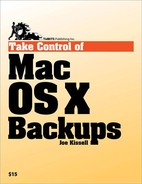Whether you call it a clone, a bootable backup, a mirror, or a carbon copy, a duplicate is a complete, exact copy of your entire hard disk that (if it's stored on, or restored onto, a hard disk) you can use to start up your computer if necessary. Duplicates are wonderful because they enable you to get back up and running extremely quickly—in most cases, with only minutes of down time.
Consider this typical scenario: you've duplicated your Mac's internal hard disk onto a FireWire drive. One day your computer won't start at all; the screen displays a blinking question mark indicating that it can't find a valid system. You suspect a catastrophic hard disk crash. No problem: you quickly hook up your backup drive and boot from that. Your computer will behave exactly as if it were running from the internal disk, with the exception that files added or changed since you performed the backup will be missing or out of date. You can then repair the internal disk—or if it's completely dead, simply replace it.
You might think it would take a while to make a copy of your entire hard disk, and you'd be right. But most software capable of making a bootable duplicate can also duplicate incrementally—meaning that after the first time, updating your duplicate to reflect the current state of your hard disk requires only copying files that are new or different. Because duplicates are so powerful and useful, I recommend that you make them part of your backup strategy.
However, due to the proliferation and simplicity of synchronization utilities, many people use duplicates as their only backup (see the sidebar Synchronization Utilities, next page). This is a bad idea. Here's why:
Duplicates provide no insurance against damaged or accidentally deleted files. If your hard disk is missing files, or contains damaged files, when you perform the duplication, those problems will appear in the duplicate as well.
Duplicates quickly go out of date. Even while your backup is in progress, files may change. So if your only backup is a duplicate, you may increase your risk that backed-up files will not be current.
For these reasons, although I urge you to duplicate your hard disk regularly, you should supplement the duplicates with archives (as I describe in The Archive, next page).
Note
An extra hard drive is certainly the best way to make a duplicate, but you can also duplicate a volume onto a disk image, which can be stored on removable media such as CD-R or DVD-R—and then restored onto a hard drive when needed. By the way, it is possible, though not easy, to make a bootable Mac OS X CD or DVD. Because this process goes far beyond normal backups, I do not cover it here.
One final note about duplicates: although you may have heard about people using a RAID (a disk array) in place of a duplicate, I think this is a bad idea except in very particular situations. I discuss this issue later in Why You Might Care About a Mirrored RAID.
